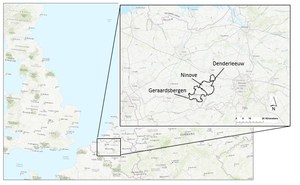Pilot description
Area description
Denderleeuw lies in the Belgian province East Flanders.
The size of the pilot area is 13,77 km2. The majority of the area is residential, or urbanized within a rural area, but there are also industrial- and retail areas, farmlands, railways and roads.
Number of inhabitants: total of 20,086 inhabitants
Relevant characteristics of the water system (main water bodies): the area lies 8 to 40 m above sea level and the main water body is the Dender river (Vlaamse Milieumaatschappij, 2016). The Dender has naturally a quick hydrological response because of the loam soils in the uphill zones. In case of intense rainfall, the river response is relatively quickly, increasing its level. Furthermore, the Dender Basin has been subject to land sealing through urbanization enhancing this process.
Figure 1: Map featuring the location of the FRAMES Belgian pilot areas, one of which is Denderleeuw.
Flood risks
Flood risks come from the Dender River; the risk probability is considered medium
- The Dender has naturally a quick hydrological response because the combination of a strong topography and the loam soils in the uphill zones (Vlaamse Milieumaatschappij, 2016). In case of intense rainfall, the river response is relatively quickly, increasing its level. Furthermore, the Dender Basin has been subject to land sealing through urbanization enhancing this process.
- The last flood of 2010 had a lot of impact and was identified as having a return period of 100 years. During these floods, an estimated 51 households were flooded (CIW, 2011). According to forecasts this could change into a 20 years return period by 2100 onward. The total financial damage after the floods of 2010 was estimated at 180.000.000 EUR for the whole Dender catchment (Tempels, 2016).
- Impacts: If a flooding occurs, the potential number of households affected would be 228 (Tempels, 2016).

